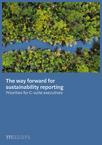The way forward for sustainability reporting
In the European Union (EU), large public interest entities (PIEs) with more than 500 employees are already subject to the Non-Financial Reporting Directive (NFRD). The arrival of the Corporate Sustainability Reporting Directive (CSRD), with its mandatory reporting requirements, will push the bar even higher as companies move to focus on quality and standards-driven sustainability reporting that will be an integral part of the management report.
Challenges for smaller entities
The challenge now is that companies with more than 250 employees, as well as listed small and medium-sized enterprises (SMEs), will come into CSRD’s scope within the next few years. As a result, they will need to prepare and publish reliable information on the full spectrum of ESG topics. In many cases, these companies that have yet to report on sustainability at a granular level will lack the time needed to put the necessary structures and processes in placeto report effectively and on schedule.
International considerations
One of the challenges at a global level is the different ESG reporting initiatives and taxonomies in force. In Latin America, Sustainability Accounting Standards Board (SASB) guidelines and the Task Force on Climate-Related Disclosures (TCFD) are becoming more appealing. Whereas in North America, the Global Reporting Initiative (GRI) is gradually gaining ground, although proposed new sustainability rules by the Securities and Exchange Commission (SEC) applying to companies listed on US stock exchanges are set to impact sustainability reporting significantly. Likewise, in the Asia Pacific (APAC) region, countries are starting to tackle ESG issues through the implementation of sustainability regulations across their stock exchange. While this represents a need for reporting standardisation, it suggests a growing awareness that sustainability reporting is set to become the norm on a global scale, albeit through different frameworks.
Supply chain issues
Of course, even for those countries that have yet to embrace mandatory sustainability reporting fully, more robust requirements in Europe do put companies who supply to EU-based companies indirectly in scope of CSRD. This places an obligation on international companies based in Europe or within the supply chain to understand and respond to CSRD reporting requirements. EU companies will gradually become more demanding in terms of data and ESG performance required from suppliers to prepare and improve their own reporting – this requires consideration of the social and environmental impacts across the entire value chain and Scope 3 is the clear current example. In addition, EU companies require some ESG information and data from their suppliers as part of the tender process and documentation.
Reporting versus action
In terms of who is responsible for ESG reporting, the Chief Executive Officer (CEO) may be more influential in driving the ESG strategy and implementing actions along with the Chief Sustainability Officer (CSO). However, with the green taxonomy and CSRD, we observe that the Chief Financial Officer (CFO) is increasingly responsible for ESG reporting, putting pressure on finance teams to upgrade competencies and make organisational changes. In countries with less ESG maturity, there is less clarity on how reporting responsibilities should be split. However, in terms of ESG transformation, ongoing discussions now point to the importance of the CEO’s role as ESG is becoming a focus point for enterprise strategy.
Communicating performance
While there’s often a focus on ESG reporting frameworks, how you communicate performance remains important. As ESG performance becomes standardised and comparable, it will be less about sharing all the positive work a company is doing for society or the environment. ESG key performance indicators (KPIs) and data points that link back to targets set will be as important. Dashboards that monitor year-on-year success or failure will help inform communication initiatives. Additionally, KPIs will be subject to comparisons and comments by analysts and ESG reporting data benchmarked against competitors. Serious explanations about the interconnectivity with financial information will also be needed for many stakeholders. This will require a review of current reporting and controlling dashboards and gradually a coordinated pushdown of the new KPIs to all levels of management to effect change.
While I hope we’ve illustrated that the time for ESG reporting complacency is over, equally, we expect this report to help companies take a few more steps along their reporting journey and broaden the discussion to how international developments can impact everyone’s reporting landscape.
We hope that this guidance on how European standards set the bar high, how the US needs to prepare for elevated ESG compliance, how Latin America and APAC aim to strengthen sustainability reporting, as well as how one company in Chile is preparing for ESG reporting helps to shine a practical light on the way forward for ESG reporting.

